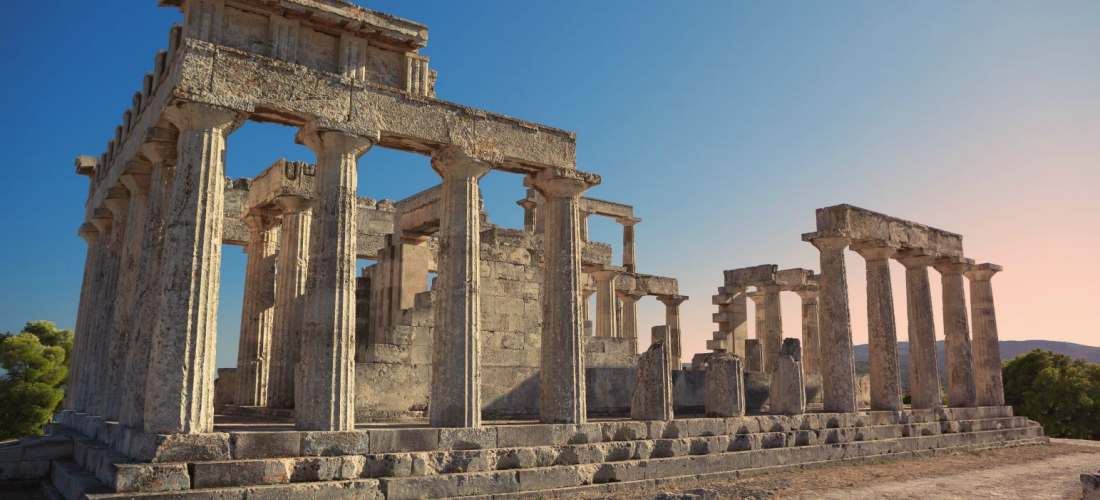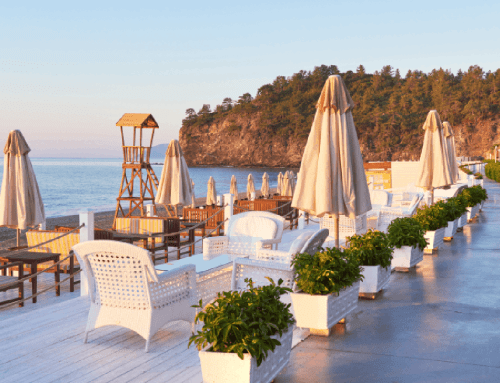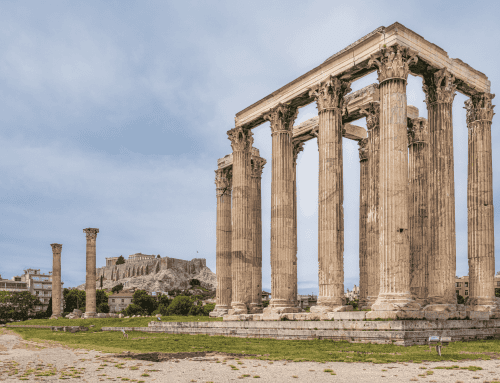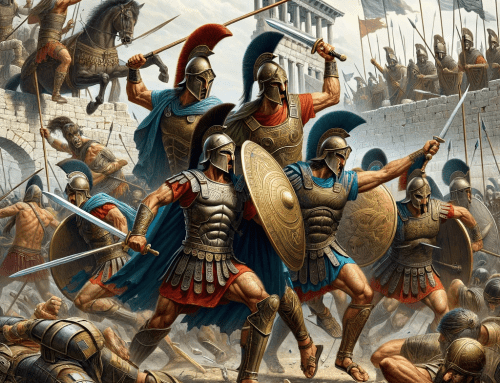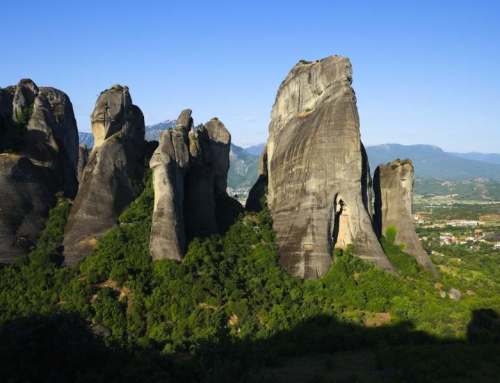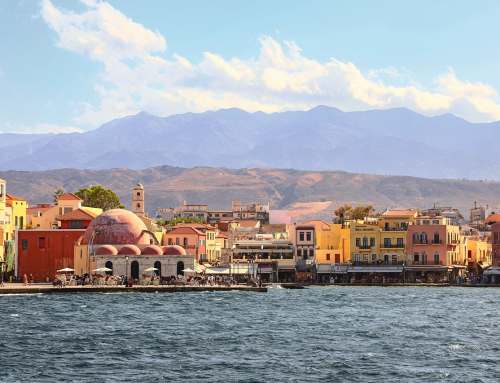Destinations / Saronic Gulf/ Aegina
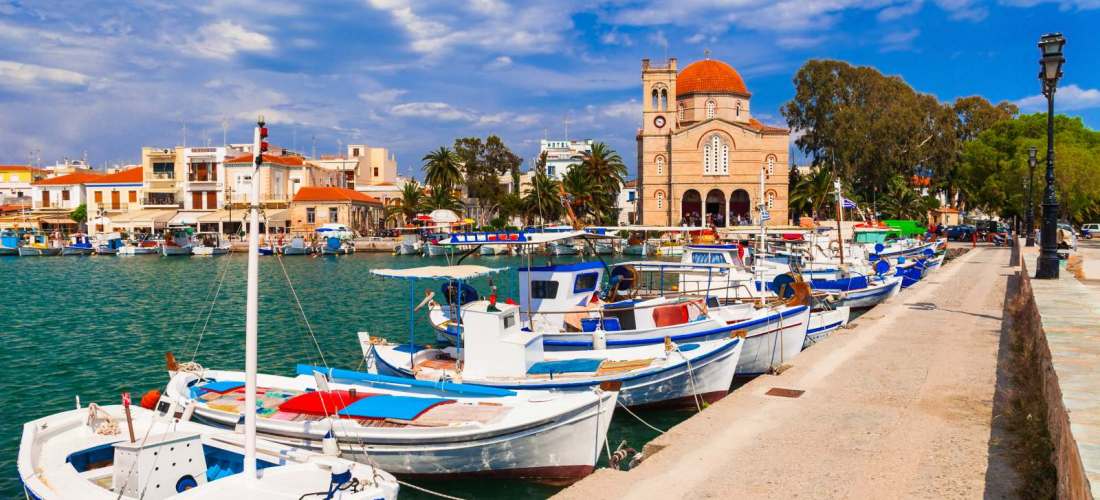
The island of Aegina (also spelled Egina, or Egine) is one of the most popular tourist destinations and one of the easiest island getaways to opt for.
Aegina island is located at only 26 km (16.5 nautical miles) south of Athens from the port of Piraeus and it is regularly served by ferries that take around 70 minutes.
From 1827 until 1829 Aegina town was the temporary capital of the newly founded Greek state, period during which the Governor Ioannis Kapodistrias had impressive neoclassical mansions built to house his headquarters that today are important tourist attractions.
Eventhough the island small, it boasts a great number of sights and natural beauties, highlight of which is the famous Aphea Temple. It forms in fact an equilateral triangle with the Parthenon and the Temple of Poseidon at Sounion, the so-called “holy triangle” of the antiquity.
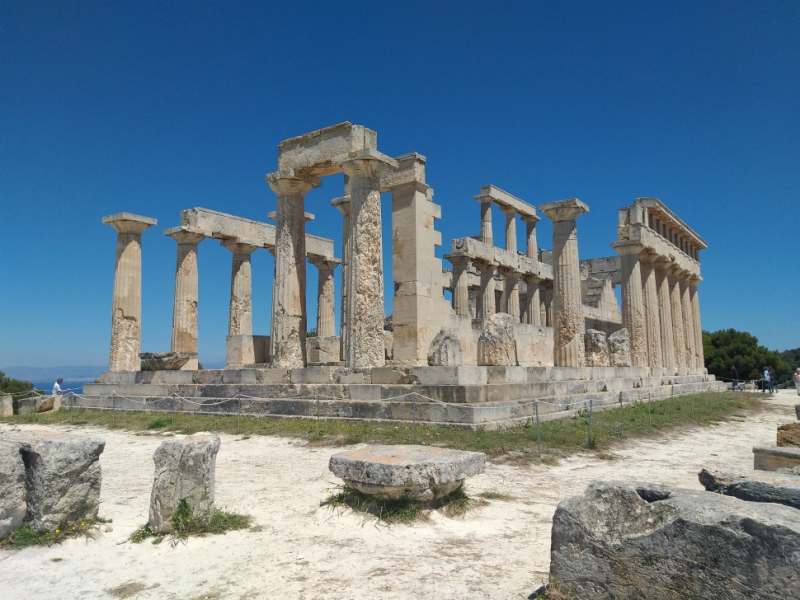 Destinations Aegina Epos Travel Tours
Destinations Aegina Epos Travel Tours
Aegina is also famous for it’s unique pistachio known internationally as the “Aegina Pistachio” with exceptional flavour and aroma which have distinquished it from other pistachios and earning well-deserved recognition as the finest pistachio in the world.
Since 2008, the Aegina Fistiki Fest or the Pistachio Festival of Aegina is a major festive event that takes place in the Saronic Gulf and the festivities include concerts with local dances, gastronomy events, creative activities, workshops for children and seminars.
Aegina town, the capital of the island, stands out for its well-preserved buildings. On the outskirts you can find charming little villages with distinctive traditional character, such as Kypseli, Agii and Vagia as well as organized tourist resorts like Agia Marina, Perdika, and Souvala. Aègina is also surrounded by many smaller islands (Moni, Metopi, Diaportia, Lagouses, Kyra, Dorousa, Spalathonisi, Anonyma) that can be reached by boat from the port of Aegina.
During your stay on the island, you can visit the following museums and sightseeings:
Museums:
- Archaeological museum
- Historical and folklore museum
- Aphea Temple (around the temple of Aphèa)
- Christos Kapralos Museum
- Governor’s Kapodistrias Residence
Welcome to Aegina!
AEGINA – MYTHOLOGY AND MORE
When you are in Athens or on the coasts of Attica or those of the Eastern Peloponnese and you look towards the middle of the Saronic Gulf, you can only pay attention to the ” όρος = mountain” -as the locals call it- of Aegina, the mountain that dominates on the island and throughout the bay.
This is the legendary «Hellanion» mountain that when I look at the top of it for a while I can see with its hands raised to the sky, the mythical king Aeacus asking his father Zeus – on behalf of all Greeks – to stop the dry weather he himself had arranged for them as their punishment, and, as a cloud-gatherer to soon bring rain to the dry land.
After all, who could the Greeks choose as a better mediator than Aeacus, since he, along with the Cretans Minos and Rhadamanthus, were the fairest people in Greece?
Zeus immediately stopped the drought by sending the coveted rain and Aeacus built a temple on the top of the mountain in his honor, the Hellanius Zeus. To this day, when the top of the mountain is covered with clouds, residents believe it will rain.
Before taking the name Aegina the island was called Oinoni. Aegina was named after the nymph Aegina, the daughter of the Asopos river, whom Zeus fell in love with and brought to Oinoni, according to Greek mythology. The result of this fiery love was the birth of Aeacus.
In order not to be left alone Aeacus and to fill the island with people and obedients, Zeus transformed all the ants of the island into people, who were called myrmidons.
So Aeacus is the ancestor of Aegina and at the same time the ancestor of some of the most central figures of Greek mythology, the Aeacidae. His sons were Telamon, king of Salamis, Peleus, king of Phthia and Phocus, whom his brothers accidentally killed in discus races.
Aeacus is therefore the grandfather of Ajax and Achilles, two legendary figures of the Trojan War.
* the name of the capital of Corsica Ajaccio, according to the most popular version, comes from Aeacus and was given this name by Ajax, king of Salamis, son of Aeacus.
** Also the most popular Dutch football club Ajax comes from Ajax of Telamon.
Another fascinating and mystical story of mythological Aegina was the one related to the sweet virgin Vritomartis.
Vritomartis was a young beautiful girl from ancient Gortys of Crete, daughter of Zeus and Karma, nymph of Artemis, as she enjoyed hunting. When Minos saw her, he fell in love with her and followed her with aggressive dispositions. To avoid him, Vritomartis fell from Mount Dikti into the sea and was saved by falling into fishermen’s nets. After escaping from Minos’ chase, one of the fishermen, Andromides, took her with him in his boat and took her to Aegina. There he tried to unite with her, without her wanting it. So Vritomartis was forced to run as fast as he could and managed to disappear into the forest. When the locals tried to find her, they found a statue of her instead of her. Then they declared the place sacred, named the invisible young girl Aphaia and worshiped her as a goddess.
When she died, she was deified and since then she protected the fishermen. In Crete there were many sanctuaries of Dyktainna, as she was called, from the name of the mountain Diktys from which she fell into the sea.
In that place the Aeginians later founded a sanctuary and later a temple was built, which dates back to the beginning of the 5th century BC, after the Battle of Salamis, in which the island also took part. The discovery of the deity took place after the discovery of an archaic inscription. The original form of her name is Afa. Before the inscriptions were found, it was considered sacred to Athena or Hercules.
The strategic location of Aegina in antiquity seems to have been the reason it was inhabited before 3,500 BC. Minoan pottery from around 2000 BC has been found in excavations, as well as gold jewelry belonging to the late Mycenaean period, which advocates the preservation of the Mycenaean civilization for several generations after the descent of the Dorians, who they seem to have conquered the island in 950 BC.
From the catalogue of ships and cities that took part in the Trojan War we see that the Aeginians participated in the campaign on the side of Argos and other cities of Argolis (Tiryns, Asini, Epidavros) under the leadership of the powerful king of Argos Diomedes, son of Tydeus. Of course, there is also the indirect participation of the grandchildren of Aeacus Achilles and Ajax who played a leading role in the siege and ultimately in the occupation of Troy.
The amphictiony of Kalaureia (Kalavria) was one of several Hellenic leagues of pre-classical times of which little is known. It had as its center the island of Poros which in antiquity was called Kalavria. In the Amfiktiony of Kalavria, as Strabo informs us, seven cities participated, Athens, Epidaurus, Ermioni, Troizina, Aegina, Prasies and the Arcadian (?) Orchomenos. The common denominator of these cities was that they were threatened by the gradual strengthening of Argos, as they were a short distance from it, which probably prompted them to form an alliance against the common enemy. This is why many archaeologists place the foundation of Amfiktiony during the 7th century BC, a period when Argos reached the height of its power.
During the Archaic period (734 – 459 BC) Aegina experienced great prosperity, evolving into a significant naval and commercial power of the time, developing an export trade of pottery and perfumes of domestic production. The Aeginians were the first to mint silver coins in Greece, a few decades after the invention of the coin by the Lydians. It should be noted that the Aeginians had significant interests in the Hellespont, while they were shareholders in the trading post of the Egyptian city of Naukratis.
The naval primacy of Aegina, the Doric origin and the consolidation of the oligarchic faction in power, in contrast to democratic Athens, created tension in its relationship with Athens. already from the end of the 6th century BC. Although during the Median Wars the Aeginians had supported Darius, in the Persian Wars they allied with the other Greek cities, and starred in the naval battle of nearby Salamis and in the battle of Plataea. After the end of the war, Aegina allied with Sparta and Corinth, resulting in a final conflict with Athens, which attacked in 458 BC. against Aegina. In the naval battle that followed, the Aeginians were defeated and their capital was occupied. The result of the defeat was the demolition of the city walls, the surrender of the ships and the imposition of a servitude tax. During the Peloponnesian War (431 – 404 BC) the Aeginians again took the side of the Peloponnesians and the Spartans and were expelled to the Peloponnese to return only after the end of the war.
In the years that followed, Aegina lost all its glory, ending up with the Aetolians and Romans. Later due to the raids of the Goths and the Heruli in Central Greece and the Peloponnese, large populations moved to Aegina, which experienced a second boom. During the 10th century the pirate raids forced a part of the inhabitants to emigrate, while then the transfer of the island’s capital to the hinterland took place, specifically to the Palaia Chora. During the last decades of the twelfth (12th) century, when piracy became widespread, Aegina became a major base for pirates.
Aegina then was occupied by the Franks (1204 – 1317), the Catalans, the Venetians and the Ottomans (1540 – 1687 & 1715 – 1821). The most important disaster, however, was carried out by Hairedin Barbarossa, who looted the capital and captured about 4,000 to 7,000 Aeginians. At the end of the 18th century, the Aeginians left the Old Town and settled on the site of the ancient city of Aegina.
During the Greek revolution it is estimated that about 400 Aeginians participated in the war. In 1827 Aegina was officially designated as -temporary- first capital of the newly formed Greek state, a position it maintained until 1829, with the transfer of the capital to Nafplio. At that time, the buildings of the Orphanage were built, which housed the school and the national printing house, the archeological museum, the government, which later housed the first library of the country.
The area of Aegina is 87 KM2 and its population is about 13,000 inhabitants. On weekends this number is much higher, as many Athenians come to Aegina to their holiday homes or stay in hotels on the island, while during the summer the population multiplies greatly.
From empirical observation I have found that the inhabitants of Aegina have a strong religious conscience and this explains the large number of temples and chapels of the island and, perhaps, the large number of Saints of Aegina, with the most characteristic representatives being Saint Dionysios and Saint Nektarios. In particular, Saint Nektarios, one of the most recent Saints of the Greek Orthodox Church with great acceptance by other Balkan peoples.
Thus, a large part of the island’s tourism is due to the religious-pilgrimage tourism with a focus on the monastery and the church of Agios Nektarios. The Saint’s fame has exceeded the limits of Greece and the Balkans and he is now becoming the world’s “man of God” through a film of the same name with famous leading actors.
To get to know Aegina well, we will start with a tour of the city and the port, “the port of the senses”. The world of the waterfront of Aegina is magical and delicious. And it’s not just the kiosks with the famous peanuts. The octopuses spread out in the sun that create surreal images in the ouzo bars of the port. The smell leads you to the charming covered fish market. But what attracts your interest are the unique, open seafront greengrocers. Now things are not transported by boats but are stored and sold on or in front of the two boats that remain permanently tied to the port of Aegina, creating an exciting picture.
We also see the Cathedral, beautiful in its simplicity, the historic Government house, the renovated historic prisons, the tower of Markellos, the traditional buildings, the cafes and the picturesque taverns and we will proceed to the column, the standing remnant of a magnificent Doric temple dedicated to god of light, Phoebus Apollo. It is worth a walk in the excavation site – where the oldest finds date from 3,000 BC, and also in the Archaeological Museum of Aegina. Continuing to the area of
After the house of Kazantzakis and the bay that follows we find the open archeological site with the tombs of the fighters of Salamis. One of the most glorious pages of Greek history, an epic is before us. The sea that was the theater of the naval battle (Naumachia) and the favourite island of classical Athens, Salamis.
Unlike Salamis, Aegina has never been a friend and ally of Athens of its own free will, as we have already mentioned. Ιn the existential war for Athens, the Peloponnesian War, Aegina was an ally of Sparta and the Peloponnesians.
Continuing the route the next stop should be the chapel of Agioi Anargyroi and, after an interesting coastal route with coves, small bays, taverns and the carnagio (shipyard), we reach the picturesque settlement and the port of Souvala.
The absolutely perimeter route is not possible. We reach Vagia and then converge towards the center of the island.
Aegina is rich in images. Among the strongest, the twenty scattered chapels – say that once upon a time there were as many of them as the days of the year, on the hill in Paliachora, which is behind the huge church and the humble monastery of Agios Nektarios on the road from Aegina to Agia Marina. Here is the Byzantine Aegina. This ” Mystras of Aegina” flourished in the period 896-1800, when people had to hide from pirates and lock themselves in a castle or hide in huge underground galleries. From the castle at the top of the hill the view to the beach of Souvala, the island of Salamis, Athens and the region of Attica is fascinating.
Of course the monastery and the church of Agios Nektarios are the big attraction for thousands of Greeks and foreign visitors. He is the most popular modern saint in Greece and the Balkans, especially in Romania.
While here I advise you to take a relatively mountainous road to the center of the island and reach a point where you cannot see the sea at all. In this location there is the beautiful church and the nunnery of Panagia Chrysoleontissa.
The mystical Aphaia
Connoisseurs may lead their minds to metaphysical paths, thinking of the equilateral triangle created by this temple together with the Acropolis of Athens and the columns of the Temple of Poseidon in Sounio, which is visible when the weather is clear, or in the belief that this area forms a secret magnetic field, the range of which is related to the importance of Delphi and Ancient Olympia. Most visitors, however, admire the shapely columns that seem to emerge from the pine forest and the magnificent view to the sea. The enjoyment of hiking friends can start as early as Agia Marina, from where they can take the path to the temple and get lost in the forest. Just like Vritomartis, who, sometimes chased by the love of Minos, sometimes by the love of an ordinary sailor, vanished here in the trees and that is why the temple built in her honor was named Aphaia (invisible).
This temple, here at the top of the hill, is one of the most well-preserved Doric pavilions. It dates from the beginning of the 5th century. Famous are the sculptures of the pediments of the temple, but few of them are in Greece. Foreign predators had a particular love for gable sculptures and most are now on display far away from Aegina.
Alternating the images and depending on the searches of everyone in the pine forest of this area there is also the nunnery of Agios Minas where you can shop local products made in the monastery.
Then we go down to the amphitheater settlement of Agia Marina and its beautiful beach with the beautiful ouzo bars by the sea. The settlement has been considered a tourist destination for over fifty years and has hotel infrastructure and many taverns.
The route continues almost coastal to the pine-covered settlement of Portes, where you can relax swimming with sea turtles and seals in the open sea overlooking the Aegean Sea. On the small hill of the settlement you can enjoy your meal in the local taverns.
The coastal route is interrupted again. We take the road that leads us to the sacred mountain of the ancient Aeginians, Mount Hellanion. We reach about the middle of the mountain where the settlement of Anitsaio is located, from where you can take a – not easy – hike for about an hour to climb to the top of the mountain and offer spears to Hellanios Zeus or to make a request for rain or whatever else you wish. Mount Hellanion is the highest peak of Aegina. It reaches a height of 532 meters. Access is not easy enough, but it is a unique experience. The trail is ideal for lovers of mountain climbing. You will see the altar of Zeus and the church of the Prophet Elias (Ascension). The view from the top is fascinating, as you can look at all parts of the horizon. Athens and the whole coastal zone of Attica up to cape Sounion, the nearby Cycladic islands, Poros and the peninsula of Methana, the Peloponnesian coast to Corinth and Megara, all the islands of the Saronic Gulf and the island of Salamis.
On your way up you can meet, with a little of luck, some proud partridges to enjoy the view το the Saronic Gulf.
Going down the mountain and taking the road to Aegina you pass through some places with an impressive view to the closed bay of the Saronic Gulf and its small islands. It is no coincidence that some real estate investments have been made here with high standards of construction .
We pass by the beautiful village of Pacheia Rachi which has traditional architectural elements. From here we are given another opportunity to walk a nice path and reach the Ancient Eleonas, on a secluded plateau with a number of centuries-old olive trees. These olives were once the ancient olive grove of Aegina. There is also a wildlife refuge in the area.
Continuing to descend walking or driving to the sea we reach the sandy beach of Marathon. Another beautiful settlement with very good taverns in front of the sea.
After a while we reach the picturesque settlement of Perdika, a traditional fishing village with many taverns along the waterfront. From here we can take the small boat to visit the amazing island of Moni. The distance is about 15-20 minutes. In summer the route is extremely popular as the small island of Moni is of rare beauty and has a wonderful beach.

Aegina Destinations Tours in GreeceSaronic Gulf Epos Travel Tours
Trying to complete the tour of Aegina and in order not to lose any part of the coastal area of the island we will approach some isolated places in southeastern Aegina looking for the windless beaches of Klima and Sarpa. Really beautiful.
This was my own approach to the island of Aegina. It is certain that you can approach it in your own best way.
Memorable Tours in Aegina, Saronic Gulf
Saronic island hopping + Peloponnese
Set sail through the Saronic gulf exploring 4 heaven-sent islands, spice up your vacations with some of the very best highlights of the most historic parts of the Peloponnese and enjoy the Theseus road back to Athens.
Do you have a bit of a sailor inside you? Cruise the Saronic gulf, fish your meal and dry your feet before visiting some of the pearls of the central Saronic islands, the most historic part of the Peloponnese and enjoy the Theseus road back to Athens.


